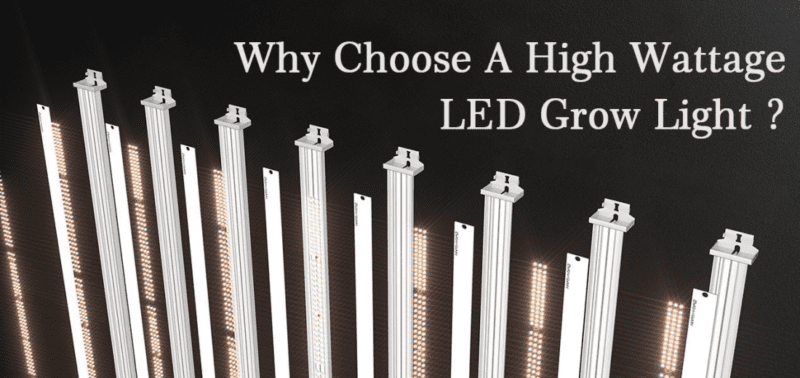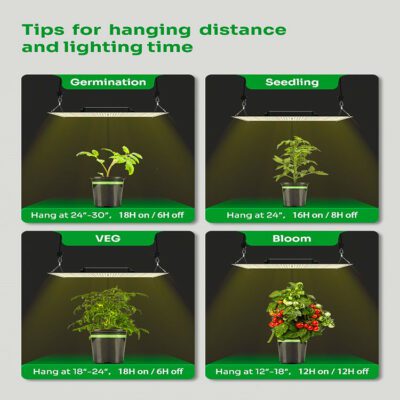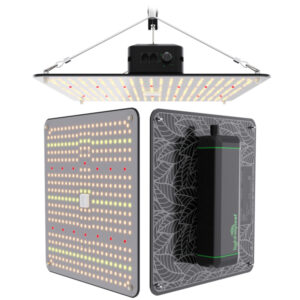What Wattage Is Required To Grow Plants Indoors? | An Ultimate Guide
June 29, 2022
By lightmyleaf
June 29, 2022
By lightmyleaf
Whether you are a professional grower or a passionate gardener, the amount of wattage required plays a role to continue your passion. It also plays an important role to make a profitable business.
Before choosing LED grow lights, you must have heard about their 75% energy efficiency. The wattage of your LED grow lights play an important role in energy efficiency. If you are a grower, you will always choose an option that consumes less wattage.
The higher the wattage required, the higher will be the energy efficiency of your grow lights. There are several factors affecting the energy efficiency and wattage of your LED grow lights.
If you are new to the world of LED grow lights, it must be hard for you to figure out the required wattage. Therefore, this article has everything that you need to know. You will come to know how much wattage it needs to grow plants indoors.

Do you think that wattage or lumen is a way to measure the energy efficiency of grow lights? This question can be solved through a comparison between LED and HPS. The supplemental lighting used HPS before the LED lighting became popular.
According to experts, an effective way to measure its efficiency is by measuring the number of lumens. It was concluded the higher the number of lumens, the larger will be the energy efficiency. However, this scene is quite different in the case of LED lights. It is because you can’t measure lumens but rather only see the brightness.
As a matter of fact, LED grow lights produce a specific spectrum to trigger photosynthesis in plants. This spectrum is not visible enough to observe through the eyes. It shows the irrelevancy of the lumens. Therefore, the energy efficiency of LED grow lights is measurable through their wattage.
The higher the wattage required, the higher will be the power and hence the higher the intensity of light.
You can measure this fact through an effective example. A 150 watts grow light can provide up to 700 umol/m²/s while an 800 watts grow light can provide 1000-1600 umol/m²/s.

If you are an old and professional grower, you must know that plants are attracted to light. Plants utilize the energy from light to grow their buds. It is only possible through a higher wattage than your plants to make higher yields. This is why you should select a light with higher wattage.

A higher wattage of LED grows lights is not only meant for higher yield. Higher wattage gives the environment to produce carbon dioxide in higher amounts. Carbon dioxide plays an important role in the process of photosynthesis.
However, you should make sure that it lies in a range of 200ppm to 1800ppm. It is because the production of CO2 higher or lower than this range can be quite dangerous. In the absence of light, carbon dioxide cannot enter benefit plants. Therefore, the light intensity should be 1000-1500 umol/s to work with carbon dioxide. For this purpose, only a higher wattage of grow lights can be effective.
The temperature should also be adjusted when increasing the carbon dioxide level. The ideal range of temperature is 75⁰F to 80⁰F for carbon dioxide absorption.

There are various factors that affect the wattage of your LED grow lights. It is important to realize that the wattage required to grow plants is not constant for every plant. The factors affecting the required wattage of grow lights are listed below:
The type of plant determines whether you need low light or high light for it. For example, peppers and tomatoes require more light from grow lights. While some low-light plants are leafy greens and herbs.
For high light plants, you need to have a high wattage for your plants. On the other hand, low-light plants require low-wattage grow lights.

The phase of growth may require different wattage at each stage. You may not need the same amount of wattage at seedlings as that of vegetation. Seedlings, flowering, and vegetation, all phases require different amounts of wattage.

It is very simple to figure out that the larger the area, the higher will be the wattage required to grow plants.

There is a myth by different people that you need 1000 watts to grow plants indoors. As a matter of fact, you can effectively grow plants even at a wattage of fewer than 1000 watts. It will save your electricity bills as well as money and you will grow healthy plants.
So the question arises, how much wattage do you really need to grow plants indoors?
During the times when HPS grow lights were popular, these lights required 1000 watts to grow indoors. At this stage, the myth got popular that it requires 1000 watts to grow plants indoors. The sad part about HPS lights is that they waste 60% of energy.
In simple words, if they waste 60% energy then only 400 watts are utilized to grow plants out of 1000 watts. This also leads to a waste of energy and your plants will not be able to get enough amount of grow lights.
The whole story shows that it is not necessary to have 1000 watts to grow plants indoors. In the case of LED grow lights, you will require lesser than 1000 watts.

When planning to grow plants indoors, it is not always about the wattage. You have to keep in mind various other things as well. In simple words, wattage can tell you about electricity consumption. You will come to know about how much your grow lights consume electricity. The wattage required for your LED grow lights has nothing to do with the energy required to grow plants.
You need to understand the LED grow light full spectrum rather than focusing on the total wattage required. The spectrum of LED grow lights is measured in micromoles. Depending upon the light hunger of your plants, you may require a different amount of micromoles.
For example, the Cannabaceae plant family requires 800 micromoles for their 85% production. Leaves, salads, and kitchen herbs require 180-380 micromoles of the spectrum.
A PAR meter can be utilised to figure out the intensity of grow lights in micromoles. It is for a light spectrum lying in a range of 400-700 nanometres.
You can say that this is suitable for any light spectrum to grow plants indoors.

You must have heard about human sunburn. The same case happens with plants as well. Through the use of too much light, the plants can easily bleach and burn.
Having more wattage can lead to more output of lighting. It also ensures more output of heat. This will lead to the burning of your plants and as a result, they will get damaged.
Your plants will go into the state of photoinhibition when having more than 1300 micromoles output. In this state, plants start spending excessive energy to get rid of the light.
It will become a hurdle in growing plants to their fullest potential. This will leave your plants with dead and brown leaves.
If you want to counteract this situation then you should feed more nutrients and introduce CO2 to your plants.
However, this can turn out to become an expensive way to grow plants indoors. You will also need 1300 micromoles of grow light with cooling systems to get rid of heat dissipation.

When buying an LED plant grow light from the market, you must have read the manufacturer’s watts per foot on its packing. However, the actual wattage to run your LED grow lights is quite different.
For example, if the given manufacturer’s wattage is 3 watts then it will lead to drawing or burning of whole power. Therefore, you shouldn’t use the manufacturer’s wattage.
According to experts, it is recommended to use 60% of the manufacturer’s wattage as the actual wattage of your grow lights typically. This will ensure healthy plant growth without damaging the grow lights.
For proper guidance, you can also consult an expert grower regarding this issue.
If you have read the whole article, you must have realized different factors that affect the wattage of types of grow lights. Now, you can get an idea about how you can effectively grow plants indoors. The idea of wattage for LED plants grow lights is quite different.
Most people consider 1000 watts necessary to grow plants indoors. However, it was just a myth. In most cases, higher wattage can be beneficial but it can be less than 1000 watts.
The selection of grow lights’ wattage depends upon factors like plant type, growth phase, and area of growth per square foot.
Lastly, if you need a piece of expert advice on growing indoor plants then Contact Us now.





Tags
Session expired
Please log in again. The login page will open in a new tab. After logging in you can close it and return to this page.